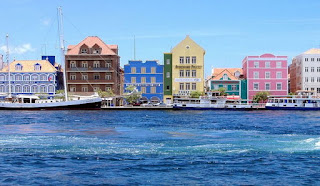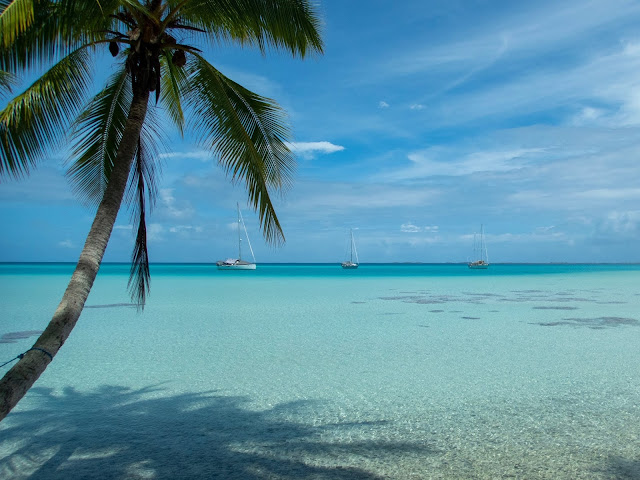Curious Curaçao - Dutch West Indies
 | |||
| Willemstad Harbour |
The flag
 I have always been fascinated by flags and try to recognise as many as I can. It is useful as boats are required to fly their National Ensign / flag of registration. Often cruisers will fly a small country flag on the port flag halyard indicating their nationality if it is not the same as the place the boat is registered. So for example you could have a Swiss guy married to a Belgium living on a Panamanian registered vessel with guests from England and France. They would fly the Panamanian flag at the stern and could fly a Swiss, Belgian, UK (or English) & French flag on the port flag halyard. The starboard flag halyard is reserved for the country courtesy flag. Flag flying on boats is steeped in history, tradition and maritime law.
I have always been fascinated by flags and try to recognise as many as I can. It is useful as boats are required to fly their National Ensign / flag of registration. Often cruisers will fly a small country flag on the port flag halyard indicating their nationality if it is not the same as the place the boat is registered. So for example you could have a Swiss guy married to a Belgium living on a Panamanian registered vessel with guests from England and France. They would fly the Panamanian flag at the stern and could fly a Swiss, Belgian, UK (or English) & French flag on the port flag halyard. The starboard flag halyard is reserved for the country courtesy flag. Flag flying on boats is steeped in history, tradition and maritime law.Knowing the meaning of a flag is not only interesting but it helps me to recongnise it too.
The Curaçaoan flag is blue with a horizontal yellow stripe slightly below the midline and two white, five-pointed stars. The blue symbolises the sea and sky divided by a yellow stroke representing the bright sun which bakes the island. The two stars represent the islands of Curaçao and Klein Curaçao, but also 'Love and Happiness'. The five points on each star symbolise the five continents from which Curaçao's people come.
The Ç
The letter c with the hook ç is called c cédille. The sole purpose of the cedilla is to change a hard c, pronounced [k], to a soft c, pronounced [s]. It is used in Portuguese too. Curaçao is pronounced 'Cure-ah-souw'.The language
Papiamentu is the local dialect. It has and lovely cadence like Spanish & Portuguese, some guttural sounds like Dutch and some ear catching words in English. Curaçaoans are taught in Dutch & Papiamentu and learn to speak Spanish & English. They seem to switch between the four languages effortlessly. We were told that Papiamentu the best language to express yourself in as it is quiet tonal so different emphasis and emotion can be delivered by the same word said differently.The Currency
Currency is always fascinating and what I find fascinating about the currency of Curaçao is that it has so many names. Not unlike the country Holland also called the Netherlands where people are Dutch (not Hollanders or Netherlanders), curiously they don't speak Hollandaise or Netherlese.The currency is the Antillean Guilder, the ISO code is ANG while the currency symbol is NAFl or just f derived from the Netherland Antilles Florin. There are 100 cents to the Guilder/Florin. Bank notes come in 10, 25, 50 & 100. Coins come in 1, 5, 10, 25, 50 cents & 1 f, 2 1/2 f & 5 f . I haven't seen a 50 piece yet (which is supposed to be diamond shaped) or a 21/2 f . But we have come across some old 5 cent - Wilhelmenia pieces which are diamond shaped. According to Numista only 1,000,000 were minted in 1948.
Where is Curaçao
Curaçao is in the southern Caribbean Sea north of Venezuela. Together with its neighbours Aruba & Bonaire it forms what is known as the ABC Islands. All of the ABC Islands have a southeast to northwest orientation.Other curious facts
Area 171 sq mi (444 sq km)
Coastline 226 mi (364 km)
Highest Point Mount Christoffel; 1,220 ft (372 m) in the north of the island
Lowest Point sea level
Natural Resources calcium phosphates
Population (2017 est) 150,000
Nationality Curaçaoan
Ethnic Groups Afro-Caribbean majority; Dutch, French, Latin American, East Asian, South Asian, Jewish minorities
Languages Papiamentu (a Spanish-Portuguese-Dutch-English dialect), Dutch (official), Spanish & English
Religions Roman Catholic, Pentecostal, Protestant, Adventist, Jehovah's Witness, Evangelical
Capital Willemstad
Form of Government constituent country within the Kingdom of the Netherlands (full autonomy in internal affairs; Dutch Government responsible for defense and foreign affairs)
Present Constitution Adopted September 5, 2010
Chief of State King Willem-Alexander of the Netherlands (since April 30, 2013); represented by Governor Lucille A. George-Wout (since November 4, 2013)
Head of Government Prime Minister Eugene Rhuggenaath (since May 29, 2017)
Cabinet Cabinet appointed by Governor
Legislature unicameral Estates of Curacao (Staten van Curacao)
Judiciary Common Court of Justice of Aruba, Curacao, Sint Maarten, Bonaire, Sint Eustatius and Saba
Per Capita Income $15,000
Principal Industries tourism, petroleum refining, petroleum transshipment, light manufacturing
Agricultural Products aloe, sorghum, peanuts, vegetables, tropical fruit
Principal Exports petroleum products
Principal Imports crude petroleum, food, manufactures
Artwork in Willemstad - the capital

 |
| Looks like a Kookaburra |






Comments
Post a Comment